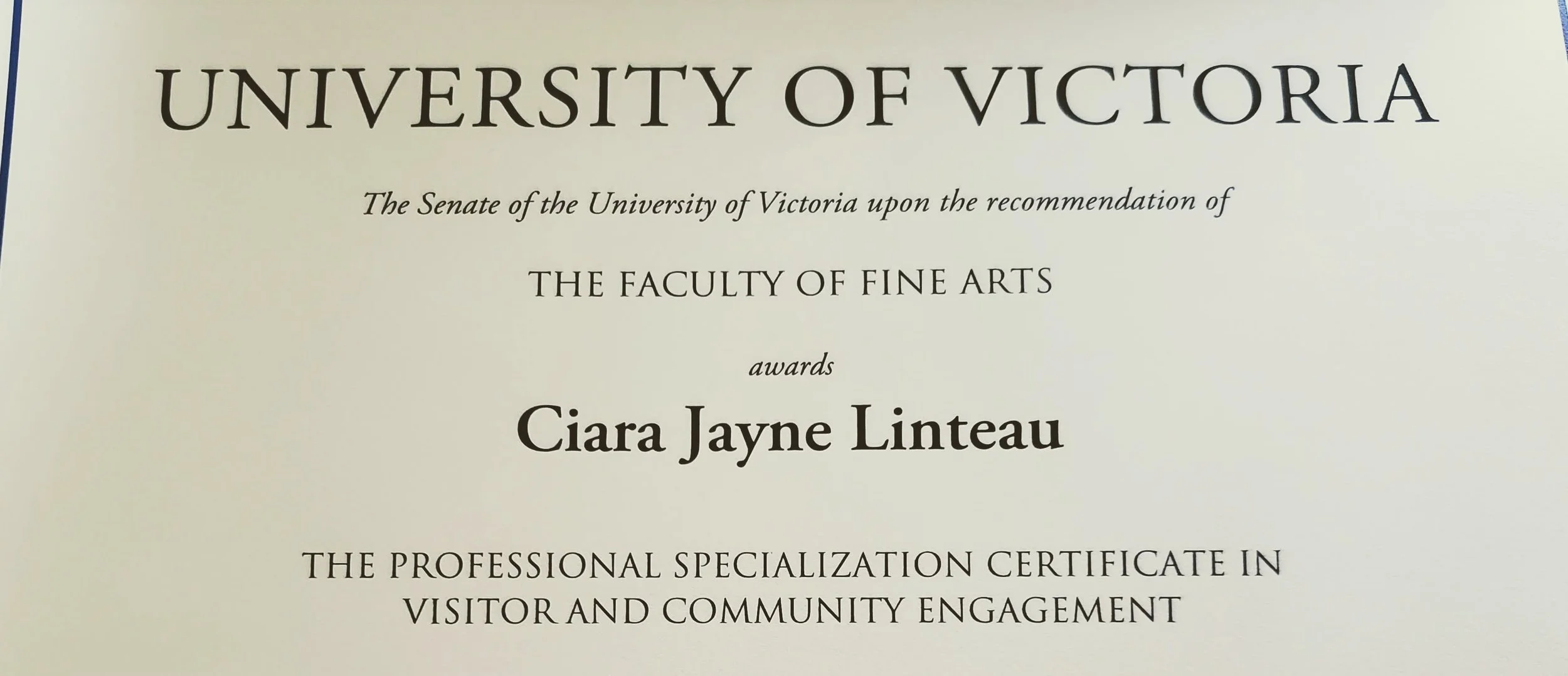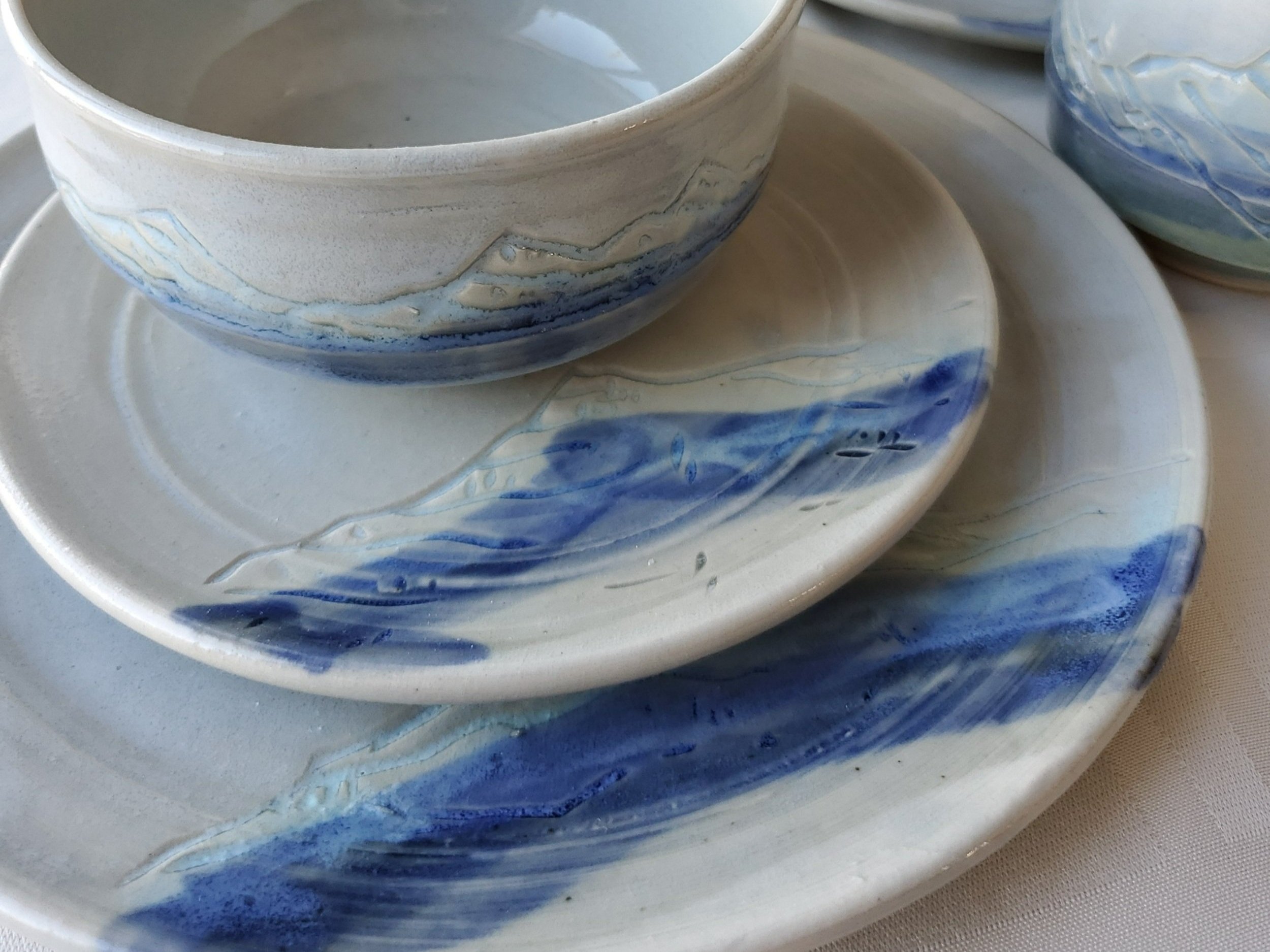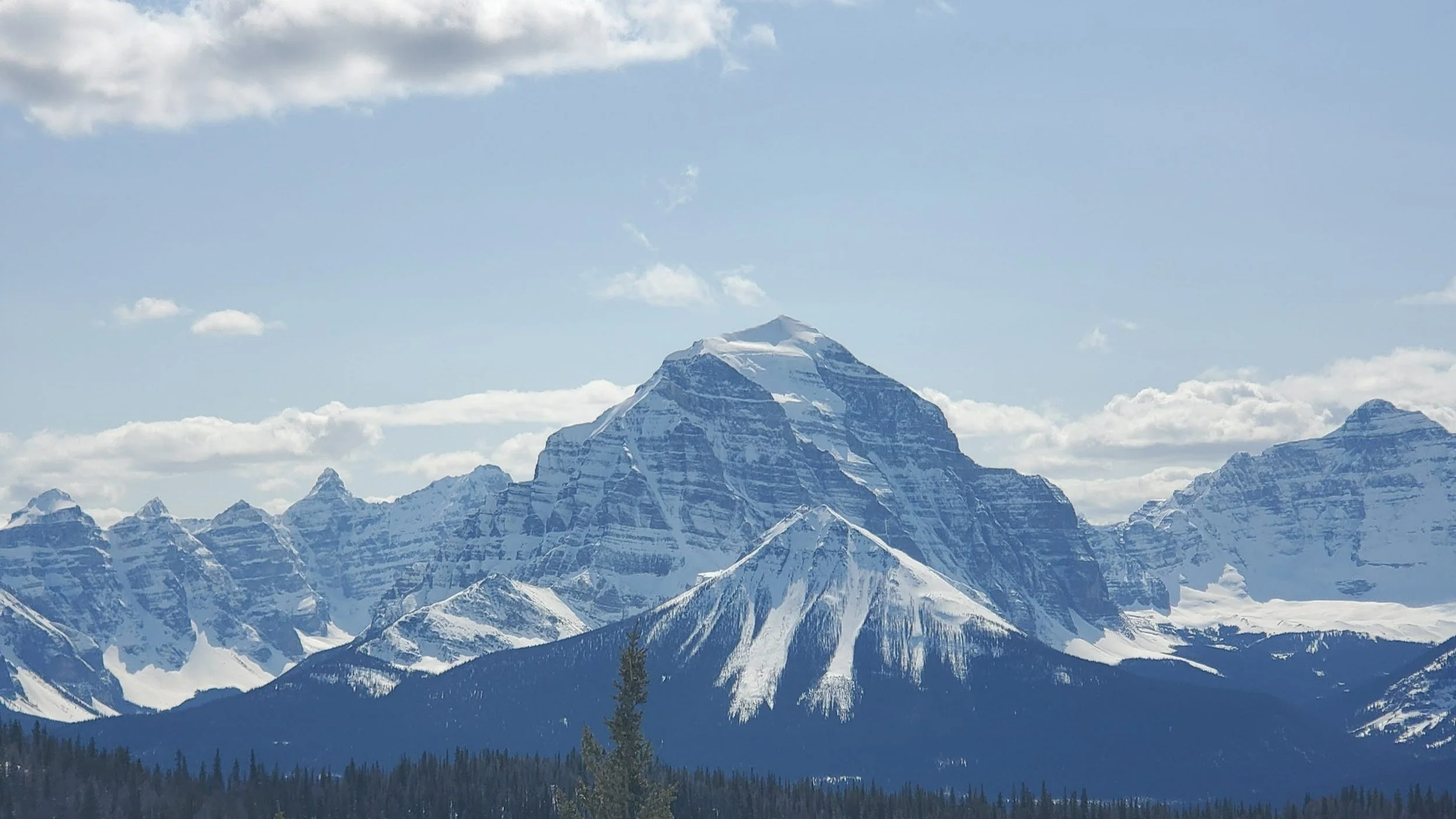Today I received my Professional Specialization Certificate in Visitor and Community Engagement from University of Victoria
School continues to be a passion of mine. I am excited and grateful to have the opportunity to complete the Professional Specialization Certificate in Visitor and Community Engagement from University of Victoria. Thank you to the Whyte Museum of the Canadian Rockies for assisting me on this endeavor financially and allowing me to write many case studies about the museums operation.
The certificate came in the mail today! I was excited to see my name in the catalogue sent as well. One more course to go to complete my Cultural Resource Management Diploma.
Out of the last 22 years, I have been enrolled in post-secondary institutes for 21 of them. Since 2017, I have been working on a Diploma in Cultural Resource Management from the University of Victoria, Continuing Studies. I have one more course to go, completing 11 courses in total to receive the Diploma and 2 certificates. The courses are demanding and I can only take one per semester. They take 7 - 14 hours of work each week for 4 months, sometimes more. And yes, lol, I have been juggling this while raising my child (who is 7 now) and also working full time for Parks Canada as Collections Specialist II, in which I am thankful to be using my Professional Specialization Certificate in Collections Management. I’ll post more about this job soon. … And this continues to be the reason for my very small production of ceramics.
This certificate really stood out to me as I particularly enjoyed doing the course work. While I always am fond of my teachers, Dr. Candace Tangorra Matelic extra inspired me. I immensely enjoyed her classes Public Programming and Community Engagement and Social Change. Her passion is contagious and I found myself wanting to make museums and their collections more accessible to a diverse public while participating in collaborations with community partners, and using multiple perspectives to tell stories. I had fun bringing my newfound knowledge to my colleagues and enjoyed the debate as we talked about the best way the Whyte Museum could increase community engagement. I found my own sense of belief in community and have actively looked for ways that I can contribute and connect more deeply. It is a privilege to live in Banff, and I am thankful for my role in preserving Banff’s history and look forward to making the gems I work in more accessible.
Mirroring my post celebrating my Professional Specialization Certificate in Collections Management post, I’ll share one of the many papers I wrote while completing this certificate. Grab a tea and sit in. I’d love to know what you think, comment below!
I took this image at Lake Louise last spring. Mount Temple, Lake Louise, 2022.
Think like a mountain: A Banff community almanac
We want to explore the natural seasons and how our interconnected community shifts and adjusts itself to meet the changing needs - Donna Livingstone, CEO
“Think like a mountain” program is inspired by Whyte Museum CEO Donna Livingstone to create new connections and engage with the Bow Valley Community. A recent consultation report done by Pivotal Research Inc. noted that the Museum needs to engage with the local community and recommendations include “technology-based interactive platforms” and “providing an “altruistic” community gathering space”. The Whyte Museum is built from one of the oldest, pioneering families in Banff and provides a strong institutional foundation capable of reconsidering its social relationship with the community and the collection (Korn). In 1978, our founder, Catharine Whyte stated “We want it always to be a friendly and pleasant place where everyone is welcome - Banff residents and visitors from all over the world. We especially hope that young people will learn from the history of their past and appreciate the beauty around them”.. This new innovative program will engage with a diverse community, including youth, deepening connections and inspiring visitors to explore, experience and learn about our mountain landscape in their own individual way (Skramstad). The phrase “Think like a mountain” coined by Aldo Leopold reminds us that mountains are complex ecosystems we are connected to. This dynamic program will use an open source program such as XWiki to create a crowdsourced platform to reflect the complex ecosystem of the Bow Valley community, creating conversations and placing the museum as a digital gathering hub (Igeo). The goals of this program are to deepen the museum's connection to the community; provide a sense of place; and raise visibility among the broader population.
The idea of the program “Think like a mountain” is to provide a framework that encourages crowdsourced digital content inspiring story sharing from diverse, interconnected communities and the mountains that influence them. With this program, the CEO is releasing new branding including the vision: “The Museum of Mountain Culture is a gathering place to engage with the evolving history, peoples, cultures, environment, and ideas of mountain cultures. We provide transformational experiences that give individuals new ways to look at the world and to consider their place in this mountain landscape”. The museum is actively moving from previous traditional institutions governing and endeavouring to become more active within the community by capturing and sharing multiple perspectives through the social memories of local history and present events (Robinson). The Museum with the community can create a social learning environment so visitors can learn from informed groups and their exchanges with peers (Hein). A broad range of visitors will find common ground as they play, build on, learn from, and create memories of shared human experience (Matelic).
Pivotal Research Inc. recommends that the Whyte Museum should engage with their traditional members and international tour groups while balancing an appeal to a broader audience including the youth, families with children, temporary residents, and foreign workers. This platform will attract groups that don’t visit museums and allow the people with varied work schedules to participate when working for them (Kotler). An increased focus on virtual space may not interest museums' older members but it can appeal to the younger population of Banff and increase their sense of belonging (Pivotal). A sense of self can be grown, modified and strengthened when interacting with museum content as individuals project themselves within the subjects motivated by their own identity-related needs (Falk). A crowdsourced program audience will include facilitators; professional and hobbyist; explorer; experience seekers and rechargers (Falk). Social interactions between diverse people of cultural experiences and overlapping values will create a unique socio-cultural public access environment creating knowledge; stimulate intergenerational conversations; represent communities that are marginalized; link and partner communities and organizations; create long term relationships; requiring openness; tangibly influence local scientific and traditional knowledge (Worts). The program will have to ensure the communities are able to provide equitable free knowledge, and improve relationships in a mediated, safe, and structured platform. (Stinson)
This program is fundamental for the whole community. Many community members are in isolation; out of work; businesses are closing; the transient population is shifting more than ever before; and there are no more tour groups. It is important for those who want to participate within the community to have some form of connection. The community lacks connection as previously government, businesses and social programs have focused on tourism and the rotating transient staff. There are many disjointed online social groups, and the Whyte Museum could unite them by encouraging their facilitators to be in the focus groups and connect or create pages to inspire. The Whyte Museum will play the role of the facilitator and connector. Creating a safe space where everyone feels that they can contribute and connecting topics and themes together bridging emotional connections of familiar ideas to the unfamiliar (Braden). A curious mind will follow these links to find new ways of thinking and productive, positive relationships will be formed (Igeo).
Visitor and market research that assessed the museums’ capabilities has been completed. The whole community, including non-traditional museum participants have been targeted to be involved and the goal is to provide a digital, crowdsourced hub to connect diverse groups within the community (Kotler). An internal planning group and an external working group that collaborates with key stakeholders and non-museum affiliates will be involved in the planning process (Robinson). These groups will determine how the program relates to community needs based on the goals provided; develop topics and themes; determine how the museum can best respond; goals and measured achievements; a strategy for development; and determine resources available (Ham). With COVID-19 in mind, I recommend that these groups start working on the crowdsourced program so everyone can get a sense for its abilities. Once complete, thematic focus groups can be created to create surveys, conduct interviews, and propose content to meet community needs. (Carter). The Bow Valley has many content creators and online facilitators that could be asked to join focus groups depending on previous interests. Guided by clear goals, objectives, and outcomes: as many individuals and groups as possible will be invited to participate. Full transparency of goals, developing plans and implementation is provided in an open fashion to build confidence and assist in developing collective ownership of content created. These new collaborations will build trust within the community and encourage people to try the new program (Robinson).
This program will be evaluated throughout the development and planning process to determine if the program is completing its original goals (Hubar). Goals can be measured through questionnaires and evaluate the site's visitor contributions and interactions. The working group will address whether the content created is for the needs and issues of the community (Worts). As this will be a dynamic, living program, debriefing meetings will happen regularly to critique what is going well and how it can be changed for the better. All participants will be thanked on a regular basis, If content creators are hired it is important to select the correct people, have contracts created and sign them and pay them in a timely fashion (Hubar)
The Whyte Museum will develop skills as an online facilitator, learning and refining its listening to support the multicultural community. The museum will facilitate mutual respect, preserve differences, and encourage new perspectives (Silverman). Accessibility and wayfinding will be focused on throughout the website, making sure the information is strategically placed, easily noticed and designed well (Bitgood).
Issues that may arise are 1. Technology: images and sound may not work; it can be outdated quickly; a professional may be required and could get expensive; 2. To many possibilities of what can be created and goals and purpose can be lost, it is important to always maintain clear objectives (Carter); 3. Previous perceptions of the museum within the community could discourage people from participating, this inventive program and transparent objectives can help open these barriers (Igeo); 4. Internal and external fear of innovative program can be removed with full transparency through all planning process and make sure goals and objectives are clear for everyone involved (Matelic); 5 .Relies heavily on volunteers and Whyte Museum does not have a volunteer base leaves room for a new volunteer program to be developed that can increase community relationships. It will be important to have a strong program foundation and infrastructure and remove barriers to provide easy access. Volunteers should be recognized and appreciated on a regular basis (Scarlett). Previous GLAM institutions that have experimented with crowdsources realized lower than expected volunteer participation, removing traditional institutional authority from content created will allow for more creative and engaging interactions. Enough resources should be allocated to ensure sufficient advertising, engage volunteers and maintain their attention (Iranowska); and 6. That enough long term planning is in place to ensure the program is sustained (Iranowska).
This program is innovative for the Whyte Museum as it shifts the focus from a traditional collection based direction towards building social relationships linking community to the collection (Korn). This program will capture the community’s imagination; contribute to improving identifying the complex and uncertain needs of the community; encourage curiosity and reflection of self; and assist in the development of a “sense of place” (Worts).
Bibliography
Bitgood, Stephen. "Visitor Orientation and Circulation: Some Guiding Principles." Developing Museum Exhibitions for Lifelong learning. Ed. Gail Durbin on behalf of the Group for Education in Museums. London: Museum & Galleries Commission, 1996. 149-151.
Braden, Donna R. "Not Just a Bunch of Facts: Crafting Dynamic Interpretive Manuals." Technical Leaflet #267. Nashville: American Association for State and Local History, 2014.
Carter, James, ed. A sense of Place: An Interpretive Planning Handbook. Bridge House: Scottish Interpretation Network, 2001.
Cassels, Richard. "Learning Styles." Developing Museum Exhibitions for Lifelong Learning. Ed. Gail Durbin on behalf of the Group for Education in Museums. London: The Stationery Office, 1996. 38-45.
Cohen, Noam. Warming Up to the Culture of Wikipedia. New York City: New York Times, 20 March 2014. 2 December 2020. <Gale OneFile: Business, https://link.gale.com/apps/doc/A362107547/ITBC?u=uvictoria&sid=ITBC&xid=39b724a8>.
Falk, John H. "The Museum Visitor Experience Model." Chapter 7, Identity and the Visitor Experience. Walnut Creek: Left Coast Press, 2009. 157-177.
Ham, Sam. "Practicing Thematic Interpretation." Chapter 2. Environmental Interpretation: A Practical Guide for People with Big Ideas and Small Budgets. Goldon: North American Press, 1992. 33-44.
Hein, George and Alexander, Mary. "Educational Theory." Museums: Places of Learning. American Association of Museums, 1999. 29-39.
Hubar, Kimberly A. and Johnson, Anna. "Planning and Managing Museum Programs and Special Events." The Museum Educator's Manual: Education Share Successful Techniques. Lanham: AltaMira Press, Rowman & Littlefield Publishers Inc. , 2009. 95-108.
Igeo, Kim and Roosa, Alexandra Marmion. "Listening to the Voices in Our Communities." Journal of Museum Education 27.2 & 3 (2002): 16-21.
Iranowska, Joanna. "16. Museum crowdsourcing—detecting the limits." The Routledge International Handbook of New Digital Practices in Galleries, Libraries, Archives, Museums and Heritage Sites. Ed. Wally Smith, Dirk vom Lehn and Steven Cooke Edited by Hannah Lewi. Abingdon: Routledge, 2020. 188-209.
Korn, Randi. "The Case for Holistic Intentionality." Anderson, Edited by Gail. Chapter 18. Reinventing the Museum: The Evolving Conversation on the Paradigm Shift. Lanham: AltaMira Press, Rowman & Littlefield Publishers, Inc., 2012. 212-222.
Kotler, Neil. "Delivering Experience: Marketing the Museum's Full Range of Assets." Museum News 78.3 (May/June 1999): 30-36, 38-9, 58-61.
Matelic, Dr. Candace Tangorra. "Unit 3 Week 5 Study Notes." n.d. Fall 2020 AHVS 488G A01 (13584). October 2020.
Pivotal, Research Inc. Whyte Museum Consultation Report. Edmonton: Pivotal Research Inc., 2017.
Robinson, Cynthia. "Create Compelling Programs Before You Market." History News 55.2 (2000): 6-8.
Scarlett, Constance. "Reimaging a Sustainable Future for Museum Volunteer Programs." Alberta Museum ASsociation Review 37.1 (2013): 28-33.
Silverman, Lois. "Making Meaning Together: Lessons from the Field of American History." Journal of Museum Education 18.3 (1993): 7-11.
Skramstad, Harold. "An Agenda for American Museums in the Twenty-First Century." Daedalus Vol. 128.No. 3 (1999): 109-128.
Stinson, Alexander D., Fauconnier, Sandra and Wyatt, Liam. "Stepping Beyond Libraries: The Changing Orientation in Global GLAM-Wiki." 9.3 (2018): 16-34.
Worts, Douglas. "Measuring Meaning Making: A Critical Assessment Framework." The Journal of Museum Education 31.1 (2006): 41-49.
Alpen Glow, Ceramics, 2021. Mountains are always on our mind in Banff. Hope you enjoyed the essay!





